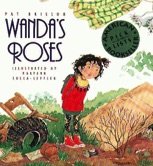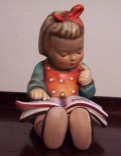Ideas for using
WANDA'S ROSES
in the classroom
When Wanda discovers a thornbush growing in the empty lot at the corner of Fillmore and Hudson, she's quite sure it's a rosebush all ready to bloom. So she clears away the trash, checks on it every day, and brings water from the butcher shop across the street. But no roses appear. Wanda's neighbors and friends are all doubtful, but when she invites them to a tea party in her "rose garden" one day in June, they're in for a big surprise.
Wanda made paper roses for her rosebush. Ask your students what type of paper they think she used. What other kinds of paper are there? Let them brainstorm in groups to see how many kinds they can list. Sandpaper, wrapping paper, wallpaper, cellophane, waxed paper, newsprint, flypaper, graphing paper, looseleaf paper and construction paper are just a few. What else could Wanda have used? Velvet, felt, net, satin, clay, vinyl, corduroy and leather are possibilities. Ask your students and art teacher for a variety of materials and have a group rose making session.
Some people think that WANDA'S ROSES is a story about ecology because Wanda and her neighbors worked together to transform a trash-filled lot into a rose garden. That's true, but that's not the whole story. It is really about a girl who has a dream and is willing to work hard to make it come true. Ask your students if they have dreams they are working to make come true. Share a dream that you have with your students. Do they know stories of other people who worked hard to achieve their dreams?
Read WILMA UNLIMITED: How Wilma Rudolph Became the World's Fastest Woman, by Kathleen Krull, to your class. Wilma had polio as a child and doctors told her she would probably never walk normally again. With hard work and determination, she proved them all wrong. Are dreams worth all the hard work?
Maryann Cocca-Leffler, the illustrator of WANDA'S ROSES, dedicated the book to her mother, Rose. What other names can you and your students think of which are the names of plants or flowers? Lily, Violet, Iris, Ivy, Laurel, and Rosemary are a few. Do your students know what their names mean? Borrow a name dictionary from the library and let them research to find out.
Talk about names for characters in stories. Would Marvin Twitchel or Drake Brawley be more likely to wear glasses? Which one would ride a dirt bike? Have your students choose names from the name dictionary and have them describe that character. Some authors fill out a page of information for each of their characters, in order to get to know them better. Let your students do this. What kind of food does the character like to eat? What is his favorite thing to wear? Does he have a certain phrase that he says all the time? Where does he live and with whom? How old is he? What's his problem? Will he solve it?
Illustrators sometimes add details to a story which are not in the text. Maryann Cocca-Leffler did this with the cat that appears throughout the entire book. If your students haven't noticed her, let them find her in the illustrations. Also notice how Maryann carried the theme of roses throughout the book. How many places can your students find them?
The author dedicated this book to her good friend, Elvira Woodruff. Elvira also writes books for young people. Have your students look for some of her books in the library catalog. If your library doesn't have any, ask your librarian to get some for you. The entire Brisson family is featured in Elvira's book, GHOSTS DON'T GET GOOSEBUMPS. Pat and Elvira have been friends since before either of them thought of becoming writers. They both visit schools and talk to kids about writing books.
Suggest to your students that they use their friends in their stories. Remind them to be kind.

